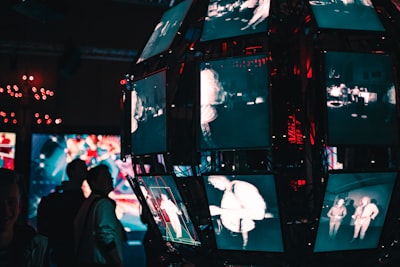In the USSR, to maintain the various official government narratives, certain facts, news and entire persons had to be silenced at all cost. In fact, when the Bolsheviks seized power in Russia in 1917, one of their first decisions was to limit free speech through censorship, of course all the while claiming they were promoting freedom. In the same year, the Soviet government signed the Degree on Press which effectively prohibited criticism of the Bolsheviks’ authority. Following this event you had 70 years of strangled freedom of expression, and severe punishments for those who dared to speak up.
Undesirable people were removed from literature, and also from photos, posters and paintings. While image retouching is easier these days, outright redactions of images is now more difficult — or?
Back in the USSR, complete censorship was possible because of centralization; because of the top-down structure. All media in the Soviet Union was controlled by the state — television and radio, newspapers, magazine, and book publishing. Today, all media is in the hands of just a handful of corporations — we have a different kind of top-down structure, and therefore, censorship is just as possible. More so, even, because we’re now in a digital world — you can control the flow of information with more precision, and on an individual basis, and you can influence what each individual sees, doesn’t see, or think they see. (You think you’re seeing a certain consensus; e.g. a majority supporting your favorite candidate/initiative/idea/etc, but what you’re just seeing is a squelched conversation; a curated flow of information).
During the Soviet era, book manuscripts had to pass rigorous approvals processes, and state owned publishing house decided whether or not to publish and distribute a certain book. It wasn’t just political messaging that was throttled, the censorship affected novels and poetry as well. Doctor Zhivago was was banned, as it focused too much on individual characters, and presumably this style of storytelling was not conducive to fostering the collectivist Soviet culture.
It was not a complete silencing of the dissenting voices though, but rather a selective bottlenecking of certain views and information. Some books which were accepted, for example, such as speeches by Leonid Brezhnev were printed up in huge quantities. Some of the less favored works might be published in limited numbers and just not distributed widely. This is what we would call shadow banning today. It was, and is so machiavellian in that it enables a facade of openness; it suggests that while there are dissenting views, they are few and insignificant (and by extension, if you share these views you are also part of the lunatic fringe).
As more and more Soviet people got their own radio receivers and foreign radio broadcasts became available, this presented a problem for the Soviet apparatchiks, as they obviously couldn’t easily censor foreign broadcasts, let alone live foreign broadcasts. The solution was to install massive radio jamming stations. These were in effect, anti-radios. Of course, even these radio jamming stations were secret — so secret that they had to be redacted whenever they were visible in photographs.
This type of jamming, we can see today. We see how unfavorable publications are being redacted from newsfeeds and search results, as well as the endless de-platforming efforts. This goes all the way to web hosting providers blocking certain undesirable websites.
But back in the Soviet Union, the doctoring of photos and pulling books, etc. those are only examples of outright and overt official censorship in Soviet. There was also a secondary type of censorship that arises as a consequence. With enough force and repercussions, the secondary effect of censorship might be self-censorship; a certain self-control by authors themselves.
There were of course, a minority of brave people opposing censorship, and they resorted to circulating handmade copies of the banned literature. This self-publishing is called samizdat. (It’s what we’d call alt-tech today, or alternative media). This was not easy, and it was dangerous. All Soviet-produced typewriters were inventoried, and what you wrote on them, was trackable. The KGB collected each typewriter’s typographic sample at the factory and stored them in the government directory. Every typewriter has their own minute little individual fingerprint, and this allowed the KGB to identify the device that was used to type or print a certain text (and arrest the offending originator).
Anyway, there were some Easter European typewriters, which did not have their samples taken and were more difficult to trace. Of course these were purchased by Soviet citizens, and were smuggled back into the Soviet Union. The brave rogue publishers These brave rogue publishers used a variety of techniques, including carbon paper, computer printers and even printing presses to create larger quantities of banned works.
The printed, banned literature had a certain look and feel. It was blurry and wrinkled, had lots of glitches and typographical errors, and dissidents in the USSR began to admire these qualities, and its rough style became appreciated. This ragged guerrilla material was the real deal and it had the scars to show for it. that samizdat material never enjoyed tremendous reach compared to the propaganda. Circulation of samizdat was relatively low, at around 200,000 readers on average, but, many of the readers were actually people of power and authority. The paradox of censorship is that in order to be able to censor verboten ideas, you have to be aware of the ideas you are censoring, so many of the government apparatchiks actually became readers of the samizdat literature. Good ideas will eventually win.
Following this long period of suffering, there was glasnost, or a reversal towards more openness in the end. Finally, in the 80’s, Gorbachev made the country’s management more transparent, and Soviet history was actually re-examined. The atrocities of Stalin were acknowledged, and people could now study key foreign events such as the manned moon landing, the US civil rights movement, which would have been suppressed prior to this. Previously censored literature in the libraries was made available. There was a greater freedom of speech for citizens and more openness in the media. So, the pendulum did swing from dystopia back towards a semblance of freedom, and we’ll get there as well. Could things get worse? Sure, and perhaps even for a lot longer, but if anything is certain it’s that history will repeat.
Supporters of taim.io.





